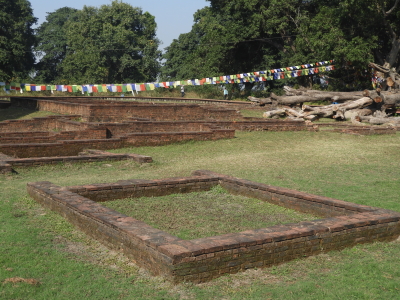Tilaurakot

Tilaurakot, the archaeological remains of ancient Shakya Kingdom is part of the Tentative list of Nepal in order to qualify for inclusion in the World Heritage List.
Tilaurakot comprises the archaeological remains of the ancient city Kapilavastu of the Shakya Kingdom. Gautama Buddha spent 29 years of his life here. The remains include three palaces, including that of the father of Gautama Buddha.
Map of Tilaurakot
Load mapThe coordinates shown for all tentative sites were produced as a community effort. They are not official and may change on inscription.
Community Reviews
Jarek Pokrzywnicki

Site visited in November, 2024.
Nepali proposal for inscription in 2026. Once a capital of ancient Shakya capital city where Siddhartha Gautam spent his princely life before he became Lord Buddha. According to data presented on information board at the entrance Tilaurakot is the best preserved Early Historic city and hinterland in South Asia. Occupied between 900 BC and 1000 AC. Archaeologists revealed remains of early village transformed in the 6 century BC (Kushan Period) into a fortified grid-planned city with many later structures (temples, houses, palaces) constructed in brick. Development continued in the first millennium AD forming central walled complex, a large brick-lined pond in the middle of the city together with multiple residential and monastic structures around an industrial suburbs beyond city walls. The complex was rediscovered in 1890 and identified as ancient capital of Shakya Kingdom associated with Siddhartha Gautam.
The site looks well prepared for being a UNESCO heritage, partly fenced, well marked with information panels in Nepalese and English. Area within city walls is equipped with wooden walkways. The most important landmarks are: partly reconstructed town walls, Eastern Gate (where according to tradition Buddha started his journey of spiritual enlightenment), temple of Samai Mai with elephants statues, central pond and central structural complex. All monuments (except the temple that looks new and still in use) are preserved in similar style like in Lumbini. If you have time you can also see the remnants of twin stupas (outside the complex – leave the side towards the Eastern Gate and turn left. Tilaurakot seems to be a local pilgrimage center for Buddhists (during my stay I saw several organised groups).
Practicalities: site is located some 40 km from Lumbini and around 4 km from the small town of Kapilvastu (connected by local public buses from Lumbini). Entrance - google coordinates 27.576107869087192, 83.05260715827669. More comfortably it is easy to organize a transport from Lumbini. Any hotel can arrange a private car with a driver for around 2500 – 3000 Nepali rupees (including waiting time on the place – it is currently around 19-22 USD). On the spot it is a small parking space just outside the Western Gate of archaeological site. Currently the site can be visited free of charge (quite unusual for Nepal), probably that will change after inscription.
In Lumbini there are hundreds of different accommodation options (different standard). I stayed in Lumbini Hotel (good enough but rather budget place) located conveniently close to Gate 5 to Lumbini complex. There are lots of different restaurants in the area. To get to Lumbini I used a flight from Kathmandu (Yeti Airlines, Bhairahawa Airport, Gautam Buddha International Airport, BWA, 75 USD one way). From the airport to Lumbini - you can use taxi – negotiate the price.
Places on the photo, bottom left, than clockwise: Samai Mai Temple with elephants, Central Pond, Eastern Gate, Central Structures.
Clyde
The best remains are the eastern gate and the 2 circular stupa foundations. It is difficult to imagine how this site could have been the wealthy city where Siddharta Gautama lived for the first 29 years of his life. Still it is worthy of being added as a WHS perhaps with Lumbini
Manisha
This site has not yielded any thing to prove conclusively that it is Kapilavastu. With due respect I must add that I can't understand how UNESCO team is so blind-folded to offer it the status of World Heritage Site, only perhaps because British team is working there.
Piprahwa on the contrary has yielded all evidences way back in 1971-1973 in form of relics and seiling with the legend Kapilavastu. Still it has received no honour forget about giving reconition to the excavator. WHY THIS PARTIALITY?
Site Info
- Full Name
- Tilaurakot, the archaeological remains of ancient Shakya Kingdom
- Country
- Nepal
- Added
- 1996
- Nominated for
- 2025
- Type
- Cultural
- Categories
- Archaeological site - South (East) Asian
- Link
- By ID
Site History
2019 Upstream Process
1996 Added to Tentative List
Site Links
Visitors
11 Community Members have visited.